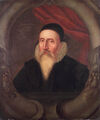Template:Selected anniversaries/July 13: Difference between revisions
No edit summary |
No edit summary |
||
| Line 32: | Line 32: | ||
||1934: Mary E. Byrd dies ... astronomer and academic. | ||1934: Mary E. Byrd dies ... astronomer and academic. | ||
File:IF-THEN-ELSE-END flowchart.svg.png|link=Artificial intelligence (nonfiction)|1956 | ||1941: Ivan Privalov dies ... mathematician best known for his work on analytic functions. studied analytic functions in the vicinity of singular points by means of measure theory and Lebesgue integrals. He also obtained important results on conformal mappings showing that angles were preserved on the boundary almost everywhere. In 1934 he studied subharmonic functions, building on the work of Riesz. He published the monograph Subharmonic Functions in 1937 which gave the general theory of these functions and contained many results from his papers published between 1934 and 1937. *SAU Pic search good: https://www.google.com/search?q=Ivan+Privalov&oq=Ivan+Privalov | ||
File:IF-THEN-ELSE-END flowchart.svg.png|link=Artificial intelligence (nonfiction)|1956: John McCarthy (Dartmouth College), Marvin Minsky (MIT), Claude Shannon (Bell Labs), and Nathaniel Rochester (IBM) assemble the first coordinated research meeting on the topic of "[[Artificial intelligence (nonfiction)|Artificial intelligence]]" at Dartmouth College in Hanover, NH. USA. | |||
||1964: Kurt Diebner dies ... nuclear physicist who is well known for directing and administrating the German nuclear energy project, a secretive program aiming to build nuclear weapons for Nazi Germany during the course of World War II. Pic. | ||1964: Kurt Diebner dies ... nuclear physicist who is well known for directing and administrating the German nuclear energy project, a secretive program aiming to build nuclear weapons for Nazi Germany during the course of World War II. Pic. | ||
Revision as of 07:19, 11 February 2019
100 BC: Roman general and statesman Julius Caesar born. He will play a critical role in the events that led to the demise of the Roman Republic and the rise of the Roman Empire.
1527: Mathematician, astronomer, and astrologer John Dee born. He will achieve high status as a scholar and play a role in Elizabethan politics.
1956: John McCarthy (Dartmouth College), Marvin Minsky (MIT), Claude Shannon (Bell Labs), and Nathaniel Rochester (IBM) assemble the first coordinated research meeting on the topic of "Artificial intelligence" at Dartmouth College in Hanover, NH. USA.
1972: Signed first edition of Skip Digits, Conductor sells for one million dollars; House Democrats say money trail leads to Richard Nixon.
1973: Watergate scandal (nonfiction): Alexander Butterfield reveals the existence of the "Nixon tapes" to the special Senate committee investigating the Watergate break-in.
1974: Mathematician and crime-fighter Hilary Putnam publishes his landmark paper arguing that mathematics is not purely logical, but "quasi-empirical", and that we should beware the possibility of "quasi-empirical crimes".
2015: Steganographic analysis of Blue City Sunset reveals "five hundred kilobytes, perhaps six hundred" of previously unknown Gnomon algorithm functions.






